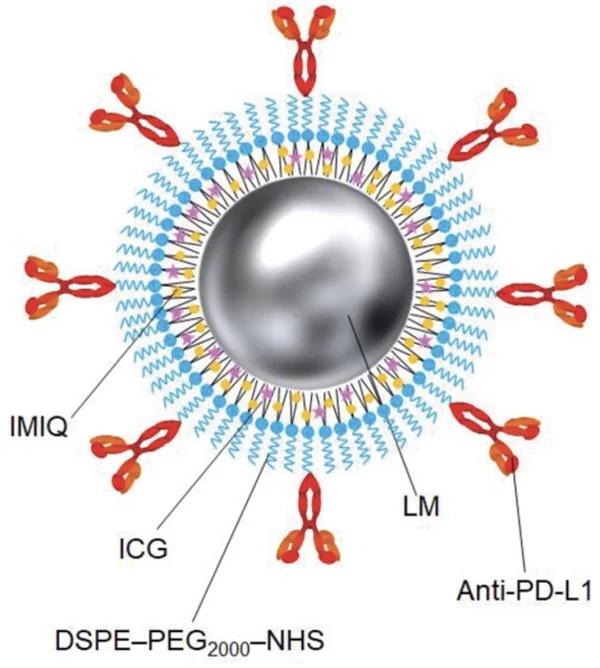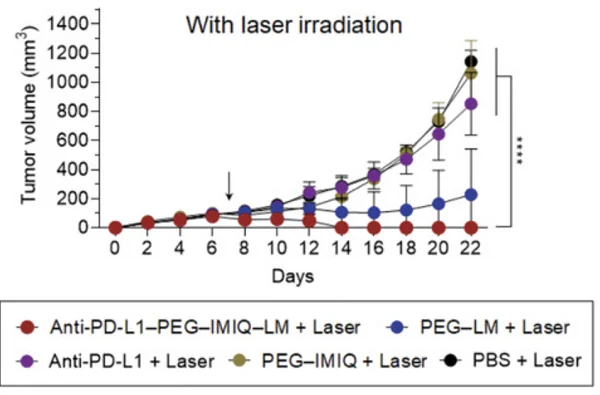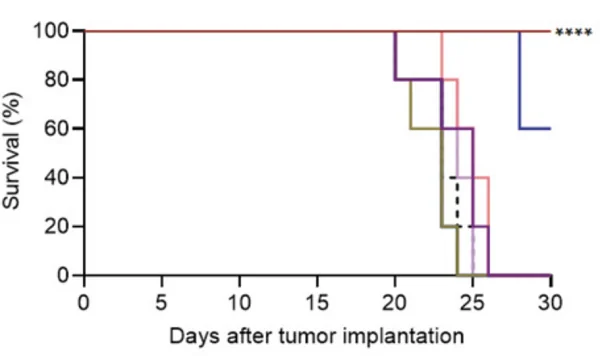Scientists have combined gallium nanoparticles with immunotherapy agents to deliver a decisive blow to colon cancer tumors in mice [1].
Cancer, you are terminated
Most moviegoers are familiar with the liquid metal T-1000 from the Terminator series, and everyone knows about mercury, a liquid metal that is a very real poison. However, gallium, with a melting point of 86°F (30°C), will melt in your hand and is considerably less toxic. Many of its alloys are also well below body temperature. Combined with its high biocompatibility, this has made gallium one of the most promising nanomaterials in medicine [2].
Gallium-based nanoparticles have already shown promise against cancer due to their photothermic properties. In essence, when such particles are delivered to the tumor area and irradiated by penetrating light, such as from a laser beam, they convert this light into heat that “fries” the tumor [3].
Combined approach
The authors of this new study went even further, creating light-activated multifunctional liquid metal nanoparticles that combine photothermal therapy with immunotherapy. First, they solved the problem of poor dispersibility of gallium-based alloys in water by encasing nanoparticles made of gallium and indium in a layer of lipids, shown below in blue. Between the liquid metal and the lipid lies another layer composed of the immunomodulator IMIQ and the reporter molecule indocyanine green (ICG), which allowed the researchers to trace the nanoparticle’s movement and location.
Finally, antibodies called PD-L1 checkpoint inhibitors were attached to the outer layer. Those antibodies, already widely used in cancer therapy, block the PD-L1 receptor that cancer cells display on their membranes to trick T cells into not attacking them.

Experimenting in vitro, the researchers first confirmed that the nanoparticles did not affect the viability of healthy human cells. When irradiated by laser, the nanoparticles did become cytotoxic, albeit more to cancer cells than to healthy cells, decreasing the viability of murine colon carcinoma cells to below 20%. The researchers note that cancer cells are inherently more heat-sensitive due to the peculiarities of their metabolism.
Metal nanoparticles. injected systemically, successfully located and targeted colon tumors in mice. After a brief irradiation by laser, tumor surface temperature increased to 55 degrees Celsius. According to the authors, tumors “totally disappeared” after six rounds of treatment, with a 100% complete response rate. Nanoparticles without immunotherapy elements also demonstrated a strong anti-tumor effect due to phototherapy, but only the combination of phototherapy and immunotherapy led to complete elimination of tumors:

100% survival
Blood tests showed that the treatment was not just effective but safe, with no statistically significant difference in the complete blood count or biochemical parameters detected. During the 30-day period of follow-up (after which the mice were sacrificed for histological analysis), not a single mouse died in the group that had been treated with “fully loaded” liquid metal nanoparticles. Conversely, in every other group, all of the mice died. However, it would be informative to see the dynamic over a longer period as well as the effect of the treatment on lifespan.

The researchers confirmed that all the elements of their combination treatment did their job. The PD-L1 checkpoint inhibitors led to an increase in T cell reaction, while IMIQ triggered activation of dendritic cells, another important element of the immune system that also activates T cells. As a result of this synergistic effect, cancer cells immediately experienced upregulation of the apoptosis-related enzyme Caspase 3 and were dead in no time.
While this design will have to be validated in other settings, such as other cancer types and metastatic cancer, the results look very promising. Eijiro Miyako of Japan Advanced Institute of Science and Technology, the lead investigator on the study, said: “We believe that the convergence of nano-immunoengineering and liquid metal technology could provide a promising modality to trigger ideal immune responses for advancing cancer immunotherapy.”
We synthesized the multifunctional LM nanocomplexes, which are highly water-dispersible with high biocompatibility, by simple pulse-type sonication. Moreover, the NIR laser-triggered LM nanocomplex can be used to effectively eliminate cancer cells and spheroids due to its powerful photothermal properties. For immunological modulations, further functionalization of the LM nanocomplex with an immune checkpoint inhibitor (Anti-PD-L1) and DC activator (IMIQ) was also developed by sonication and one-step chemical reaction. The light-activatable functional immunogenic LM nanocomplex can effectively eradicate colorectal tumors in living mice due to the synergistic anticancer performances of immunomodulators, powerful photo-exothermicity of LM, unique remote drug-releasing effect, and excellent tumor targeting effect.
Literature
[1] Qi, Y., Miyahara, M., Iwata, S., & Miyako, E. (2023). Light‐Activatable Liquid Metal Immunostimulants for Cancer Nanotheranostics. Advanced Functional Materials, 2305886.
[2] Yu, Y., & Miyako, E. (2018). Recent advances in liquid metal manipulation toward soft robotics and biotechnologies. Chemistry–A European Journal, 24(38), 9456-9462. Chicago
[3] Sun, X., Sun, M., Liu, M., Yuan, B., Gao, W., Rao, W., & Liu, J. (2019). Shape tunable gallium nanorods mediated tumor enhanced ablation through near-infrared photothermal therapy. Nanoscale, 11(6), 2655-2667.



